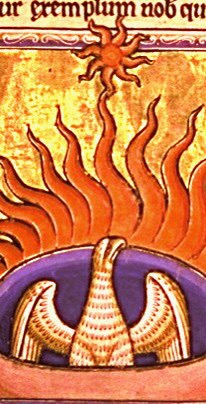 [The Errors of Inerrancy: A ten-part series on why Biblical Inerrancy censors the Scriptures and divides Evangelicals.]
[The Errors of Inerrancy: A ten-part series on why Biblical Inerrancy censors the Scriptures and divides Evangelicals.]
The Errors of Inerrancy: #4. Inerrancy denies that the Bible contains scientific errors
Introduction
Herman Bavinck said, "Scripture does not tell us how the heavens move but how we move to heaven." [1] And so, "It is probable that the authors of Scripture knew no more than all their contemporaries about these sciences, geology, zoology, physiology, medicine, etc." [2] The Biblical Authors did not correct the scientific errors of the ancient world, instead they preached the Word of God in-and-through the same common language and primitive scientific knowledge of the world in which they lived. The fourth Error of Inerrancy is denying that the Bible contains scientific errors because the Bible must not be scientifically precise to be true, as Bavinck said, "Holy Scripture uses the language of everyday experience, which is and remains always true." [3]
Modern Science is Foreign to the World of Scripture
Science originated with the dawn of Humanity in the creation of stone tools, but the Scientific Method was not widely established until the modern era, over a millennia after the last books of the Bible were written, and after the Protestant Reformation began. It should be obvious that the Bible doesn't contain scientific literature because the Scientific Method is foreign to the world of Scripture. In his commentary on Gen 1:6-10, Dietrich Bonhoeffer said, "Here we have before us the ancient the ancient world picture in all its scientific naïveté." [4] We should expect an ancient document to possess all the hallmarks of ancient world in which it was written, and it is more important to communicate truth in a way that the ancient reader would understand, rather than communicate esoteric scientific knowledge that they would never understand.
The Biblical Authors shared the same inaccurate knowledge of earth history and science as their contemporaries, and from in-and-through this frame of reference, they then preached the Word of God. Bavinck said, "For that reason it speaks of 'land approaching,' of the sun 'rising' and 'standing still,' of blood as the 'soul' of an animal, of the kidneys as the seat of sensations, of the heart as the source of thoughts, etc. and is not the least bit worried about the scientifically exact language of astronomy, physiology, etc." [5] Denying the Bible contains scientific errors a priori rejects the very frame of reference from which the Bible authors wrote, making it impossible to interpret it in context (or rightly!) Therefore, Inerrancy is a modern bias that necessitates that the Bible is read out-of-context by censoring the Biblical Authors of any scientific errors. There's a twofold danger in this modern bias of applying scientific precision to the Bible: the first is to misunderstand the Biblical author by interpreting his message in a way contrary from the way they understood the world, and the second is to correct modern science with a Biblical author's antiquarian worldview.
Biblical Inerrancy and Science
Biblical Inerrancy asserts that the Biblical authors wrote in such a way, that they committed no scientific errors whatsoever. For instance, the Chicago Statement, Article XII says "We deny that Biblical infallibility and inerrancy are limited to spiritual, religious, or redemptive themes, exclusive of assertions in the fields of history and science. We further deny that scientific hypotheses about earth history may properly be used to overturn the teaching of Scripture on creation and the flood." [6] I agree that science may not 'overturn' the Bible, because the Bible does not reveal falsifiable scientific knowledge (as I previously explained). But, by mentioning 'creation and the flood', this article is asserting that the protohistory of Genesis 1-11 is indeed revealing scientific knowledge after all. So the Chicago Statement's definition of Inerrancy is indistinguishable from Biblical Literalism! It's possible that one of the ancient near east floods may correlate to Genesis Flood, but this does not mean that Geologist must confirm their scientific inquiry to the protohistory of Genesis 1-11. Whether a flood event occurred, and whether the extent was local or global, may not be determined by Genesis 1-11. The Genesis Flood is essential to the Bible, but it does not dictate what is essential to scientific and geological history of the Earth.
In this Errors of Inerrancy series, I'm defining "Inerrancy" by the Chicago Statement, but not all proponents of Inerrancy assert that the Bible is scientifically error free. There are Biblical Scholars and organizations that affirm a form of inerrancy yet acknowledge that the Bible does not reveals scientific knowledge, such as the excellent works of John H. Walton and BioLogos (which I've contributed to in the past) and are outside the purview of this post.
Clement's Phoenix
 In 1 Clement 25, the mythical Phoenix is used to explain the resurrection. Clement was unaware that the Phoenix was a myth, but the truth of the resurrection is communicated effectively in his letter to others who also believed that that the Phoenix was a real creature.According to the logic of Inerrancy, falsifying the existence of the Phoenix would falsify the truth of the resurrection that Clement describes.
In 1 Clement 25, the mythical Phoenix is used to explain the resurrection. Clement was unaware that the Phoenix was a myth, but the truth of the resurrection is communicated effectively in his letter to others who also believed that that the Phoenix was a real creature.According to the logic of Inerrancy, falsifying the existence of the Phoenix would falsify the truth of the resurrection that Clement describes.
From Clement's frame of reference, the Phoenix was a real creature, that he used to explain the truth of the resurrection. To assert that the Phoenix was a real creature (as some people do with Rahab, Leviathan, and Behemoth), would undermine the force of Clement's argument for the resurrection. And it would be wrong to correct modern zoology, by asserting that the Phoenix is a real creature because of Clement's reference to it. And lastly, demonstrating that the Phoenix is a mythical creature, absolutely does not make the resurrection a myth.
"The Phoenix, an emblem of our resurrection"
Let us consider that wonderful sign [of the resurrection] which takes place in Eastern lands, that is, in Arabia and the countries round about. There is a certain bird which is called a phoenix. This is the only one of its kind, and lives five hundred years. And when the time of its dissolution draws near that it must die, it builds itself a nest of frankincense, and myrrh, and other spices, into which, when the time is fulfilled, it enters and dies. But as the flesh decays a certain kind of worm is produced, which, being nourished by the juices of the dead bird, brings forth feathers. Then, when it has acquired strength, it takes up that nest in which are the bones of its parent, and bearing these it passes from the land of Arabia into Egypt, to the city called Heliopolis. And, in open day, flying in the sight of all men, it places them on the altar of the sun, and having done this, hastens back to its former abode. The priests then inspect the registers of the dates, and find that it has returned exactly as the five hundredth year was completed. [7]
I intentionally chose 1 Clement as an example, because everyone today acknowledges that the Phoenix is a mythical creature, and because this letter is not part of the Bible, in order to avoid bickering over "Bible Difficulties". 1 Clement is striking similar to 1 and 2 Corinthians, because it was written in the same Koine Greek, to Corinth, and before the New Testament was completed, by a leader in the early Church in Rome. So it has striking similarities and proximity to the New Testament.
There are similar examples to Clement's Phoenix in the Bible, where the author makes an argument based on their limited knowledge of science long ago that we now know to be false. Is 1 Clement's use of the Phoenix invalidated by the myth? By no means! It does mean that we must demythologize 1 Clement, so that we may recognize that the Phoenix is a myth without setting aside the truth of the resurrection that 1 Clement teaches us all.
It's Good that Scripture Doesn't Contain Science
In a final word from Herman Bavinck, the Bible is better off without being committed to any scientific theory. Science is a developing enterprise of it's own, and recognizing that the Bible utilizes the common understanding of the world in which it was written, helps us understand its message better than if it revealed perfect science originating a long time ago in a galaxy far far away that no common person would ever understand.
If, instead of this, Scripture had used the language of the academy and spoken with scientific precision, it would have stood in the way of its own authority. If it had decided in favor of the Ptolemaic worldview, it would not have been credible in an age that supported the Copernican system. Nor could it have been a book for life, for humanity. But now it speaks in ordinary human language, language that is intelligible to the most simple person, fear to the learned and unlearned alike. It employs the language of observation, which will always continue to exist alongside that of science and the academy. [8]
Conclusion
In this fourth installment in the Errors of Inerrancy, the dangers of denying the Bible contains scientific errors has been explained. The example of the Phoenix as an emblem of our resurrection, demonstrates how we may rightly interpret the Bible in the way it was intended to be interpreted. And, the threefold error of denying the Bible contains scientific errors demonstrates that it is impossible to understand the Bible when its true context is rejected a priori by our modern biases. This error is multiplied when scientific errors in the Bible are used to censor and correct modern science.
References:
[^1] Bavinck, Herman. Reformed Dogmatics: Prolegomena. Ed. John Bolt. Trans. John Vriend. Vol. 1. Grand Rapids, MI: Baker Academic, 2011. 445-6. Print.
[^2] Ibid.
[^3] Ibid.
[^4] Bonhoeffer, Dietrich. Creation and Fall; Temptation: Two Biblical Studies. Trans. John C. Fletcher. New York: SCM, 1997. 30. Print.
[^5] Ibid.
[^6] Ibid.
[^7] 1 Clement 25.
[^8] Ibid.
The Errors of Inerrancy: A ten-part series on why Biblical Inerrancy censors the Scriptures and divides Evangelicals:
#1 The Church has never possessed an inerrant Bible
#2 Inerrant Original Autographs are a Tautology of Biblical Inerrancy
#3 Inerrancy Censors the Bible’s Capacity for Error
#4 Inerrancy denies that the Bible contains scientific errors
#5 Inerrancy reduced the Biblical Authors into Ventriloquist Dummies
#6 Inerrancy obscures Jesus with the Bible
#7 Biblical Inerrancy’s Myth-Making Machine, Unveiled
#8 The Protestant Reformers Would Not Affirm Biblical Inerrancy (Martin Luther, John Calvin, et al.)
#9: Inerrancy turns the Bible into a Paper Pope.
#10: Biblical Inerrancy Divides Evangelicals



Leave a comment